工程管理专业英语
- 格式:pptx
- 大小:522.27 KB
- 文档页数:40
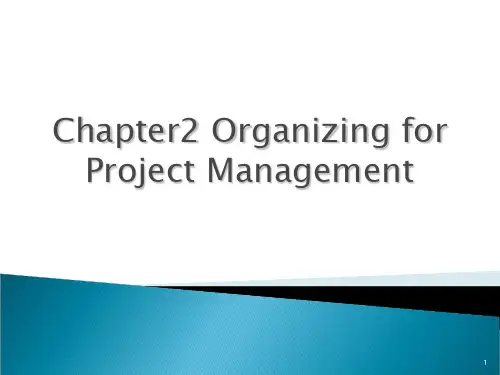

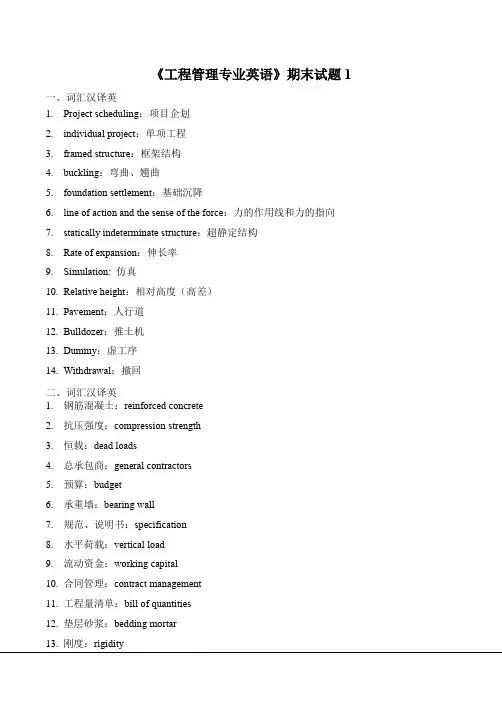
《工程管理专业英语》期末试题1一、词汇汉译英1.Project scheduling:项目企划2.individual project:单项工程3.framed structure:框架结构4.buckling:弯曲、翘曲5.foundation settlement:基础沉降6.line of action and the sense of the force:力的作用线和力的指向7.statically indeterminate structure:超静定结构8.Rate of expansion:伸长率9.Simulation: 仿真10.Relative height:相对高度(高差)11.Pavement:人行道12.Bulldozer:推土机13.Dummy:虚工序14.Withdrawal:撤回二、词汇汉译英1.钢筋混凝土:reinforced concrete2.抗压强度:compression strength3.恒载:dead loads4.总承包商:general contractors5.预算:budget6.承重墙:bearing wall7.规范、说明书:specification8.水平荷载:vertical load9.流动资金:working capital10.合同管理:contract management11.工程量清单:bill of quantities12.垫层砂浆:bedding mortar13.刚度:rigidity三、典型句子英译汉1、All these loads depend largely on the location of the building, have to be taken by the structural system from all points and manners of application and transferred to the foundations.所有这些荷载,在很大程度上取决于建筑物的位置,这些荷载由结构体系从各个点以各种作用方式传递到基础。
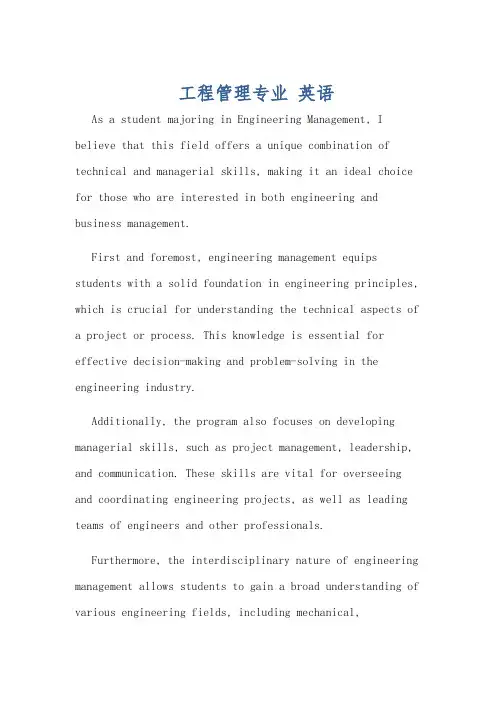
工程管理专业英语As a student majoring in Engineering Management, I believe that this field offers a unique combination of technical and managerial skills, making it an ideal choice for those who are interested in both engineering and business management.First and foremost, engineering management equips students with a solid foundation in engineering principles, which is crucial for understanding the technical aspects of a project or process. This knowledge is essential for effective decision-making and problem-solving in the engineering industry.Additionally, the program also focuses on developing managerial skills, such as project management, leadership, and communication. These skills are vital for overseeing and coordinating engineering projects, as well as leading teams of engineers and other professionals.Furthermore, the interdisciplinary nature of engineering management allows students to gain a broad understanding of various engineering fields, including mechanical,electrical, civil, and industrial engineering. Thisholistic approach enables graduates to work across different sectors and industries, providing them with diverse career opportunities.Moreover, the increasing complexity of engineering projects in today's globalized world demands professionals who can not only understand the technical aspects but also manage the business and financial aspects of the projects. This is where the knowledge and skills gained from an engineering management program become invaluable.In conclusion, studying engineering management provides a well-rounded education that combines technical expertise with managerial acumen. This unique combination prepares students for a successful career in the dynamic and challenging field of engineering.作为一个主修工程管理的学生,我相信这个领域提供了技术和管理技能的独特结合,使其成为那些对工程和商业管理都感兴趣的人的理想选择。

工程管理专业英语词汇A Cash flow profile现金流量图Credit risk信用风险 As-built drawings竣工图Competitive biddingAnnual net value净年值公开招标 Arbitration仲裁A dashed line虚Contract price合同价格线 Clause条款Activity-on-branch network双代号网络Contract negotiation合同谈判图Contract dispute合同纠纷 Activity-on-node network单代号网络Cost overrun成本超支图 Cost committed承诺成本Cost to date到期成本 A vertical axis纵坐标Archival information档案资料 Cost exposure附加成本Critical path method关键线路法Construction yard施工现场 BBottom-up design自下而上的设计Bids and quotations投标和报价 DBill of quantities工程量清单 detailed engineering design详细的工程设计 Bid estimate 投标估价design methodology设计方法 Benefit cost ratio成本收益率Budgeted cost预算成本 detailed design详细设计drilling and blasting钻孔和爆破detailed estimates详细估算 CConceptual planning stage概念规划阶dispute resolution mechanism争端解决段机制Capital intensive资金密集的 design drawing设计图纸 Competitive bidding竞争性招/投标 dummy activities虚工作 Contract price合同价格claims索document control文档控制赔Constructors建造商 Echanges变更 clause条款 Economic feasibility经济可行性 Conceptual design概念设计 Estimate stage估算阶段 construction operations施工作业evaluation stage评估阶段 Construction contractor施工承包商 equipment utilization and mechanizationConstruction equipment施工设备设备利用率和机械化 Concrete mixers混凝土搅拌机 earthwork to be excavated土方开挖 Cost estimation成本估算Economic evaluation经济评价 Cost control成本控制 Expenditure支出Cost Engineering工程估价 Excavation开掘Construction supervision施工监督 Estimated total cost预计总成本Construction cost建造成本Control estimate控制估算 FConceptual estimate概念设计估算 Feasibility study可行性研究Construction procedures施工方法 Facility operation and maintenance设施Cost indices成本指数的运营与维护 formulation构思 Consumer price index 消费价格指数 Facilities management设施管理 line" chapter, and signature confirmation. Article 17th account manager by the people's bank credit system query print credit report to verify the credit histories and guaranty to the parties. No credit report or credit score, through field surveys or other means to implement the credit situation and external security situation, according to riskFunctional organization职能式组织 Matrix-type suborganization矩阵式次First line supervision基层监督级组织Field management现场管理 Monitoring and control监督与控制 Force-account charges自营工程费 Material procurement and delivery材料Free float自由时差采购和运输Fast track快速路径法 Mortgage抵押 Milestone里程碑 Final checkout最终的竣工验收 Municipal project市政项目 G Monte carlo simulation蒙特卡罗模拟 Gantt chart甘特图NH Horizontal axis水平坐标 Nominated subcontractor指定分包商Non-productive activities非生产性活动 I Net annual cash flow年净现金流 Integrate整合 Net benefit净收益 Negotiation谈Instruction and commercial building 判construction 办公和商业用房建设 Net present value净现值Infrastructure and heavy construction重Net future value净终值大基础项目建设 Numerous alternative plans众多的备选Installation contractors安装承包商方案Ill-defined定义不清的 Network diagrams网络计划图 Inflation通货膨胀Internal rate of return内部收益率 OIntangible asset无形资产 Overlap 搭接,交叠 on-site现场 Interest rate利率 Operation and maintenance managers运In-house overhead expenses内业管理费行与维护经理Independent float独立时差 On-site Installation现场安装 Inspection logs检查日志 Overseer监督者 Overdraft透支 Information transfer andflow信息的传Overlapping and rehandling搭接和再处递与流通 information flow信息理流PL Procurement Management采购管理 Linear programming线性规划 Public agency公共机构 logistics物流 labor productivity劳动Professional services专业服务生产率 Project organization项目式组织 labor jurisdictions劳动仲裁 Preliminary estimates初步估算 logistic problems 后勤问题 Payback period投资回收期 lifting and erecting提升和安装Payment支付leverage杠杆作用 Private corporation民营公司 legal documents法律文件 Predecessor relationship前后顺序关系 lump sum contract总价合同 Pre-qualification of contractors andsub-contractors with regard safety在安M 全方面对承包商和分包商的资格预审 Monthly payments月付款额 Procurement accounts采购账目kore, through field surveys or other means to implement the credit situation and external security situation, according to risreport to verify the credit histories and guaranty to the parties. No credit report or credit sc line" chapter, and signature confirmation. Article 17th account manager by the people's bank credit system query print credit2商Q The feasibility study report可行性研究Quotation报价报告The state of economy经济状况 R Turnkey project/contract交钥匙工程/合Residential housing construction住宅类同房屋建设 risk-reward风险和回报 Top-down design自上而下的设计 Return on investment投资回收率 Technical feasibility技术可行性 Revenues收入Tangible asset有形资产 Real estate properties房地产 Technology choice 技术选择 Total Risk sharing风险分担 float总时差Re-construction返工,重修 Total quality control全面质量管理 Re-evaluation重新评价 Tracing decision跟踪决策 Random sample随机抽样Relational data model关系数据模型 US Unit cost method of estimation单位估Speculative housing market投机性住宅价法市场 Unit price contract单价合同 Scope of the project项目的范围Unforeseen circumstances不可预见事Specialized industrial construction 专业件化工业项目建设 sensitivity灵敏度 VShop drawings施工图 Vendor供货商 Value engineering价Subcontractors 分包商值工程Specialty Contractor专业承包商 Video conferencing电视会议Specialized subcontractor专业分包商Structural design结构设计 WSecurity sensitivity安全敏感性 Work package工作包 Screening estimates匡算 Warranties and guarantees保证和担保 Subcontractorquotations分包商报价 Warehouse management仓库管理 Social rate of discount社会折现率Simulate模拟 sunk cost沉没成缩写本 REITs—real estate investment trusts房Semi-automated半自动化的地产信托(基金)Sub-network子网络图 Statistical PERT—program evaluation and review method统计方法 technology计划评审技术 Sampling by attributes特征抽样 PMBOK—project management body ofSampling by variables变量抽样 knowledge项目管理体系 Sampling plan抽样计划 PMI—the project management instituteStorage and retrieval存储和查询美国项目管理协会ISO—the international organization forT standardization国际标准化组织 The project life cycle项目生命周期OSHA—US occupational safety andThe Real estate developer房地产开发health administration美国职业安全和veys or other means to implement the credit situation and external security situation, according to riskcredit report to verify the credit histories and guaranty to the parties. No credit report or credit score, through field sur line" chapter, and signature confirmation. Article17th account manager by the people's bank credit system query print3 健康署GDP--gross domestic product国内生产总值GNP--Gross National Product国民生产总值MARR--minimum attractive rate ofreturn最低收益率CMC—construction management contractor建设项目管理承包商CAD—computer aided design计算机辅助设计CPA--Certified public accounting特许公共会计师AIA—American institute of architects美国建筑师协会AGC—the associated general contractors美国总承包商会任永富Thursday, December 09,2010kore, through field surveys or other means to implement the credit situation and external security situation, according to risreport to verify the credit histories and guaranty to the parties. No credit report or credit sc line" chapter, and signature confirmation. Article 17th account manager by the people's bank credit system query print credit4。
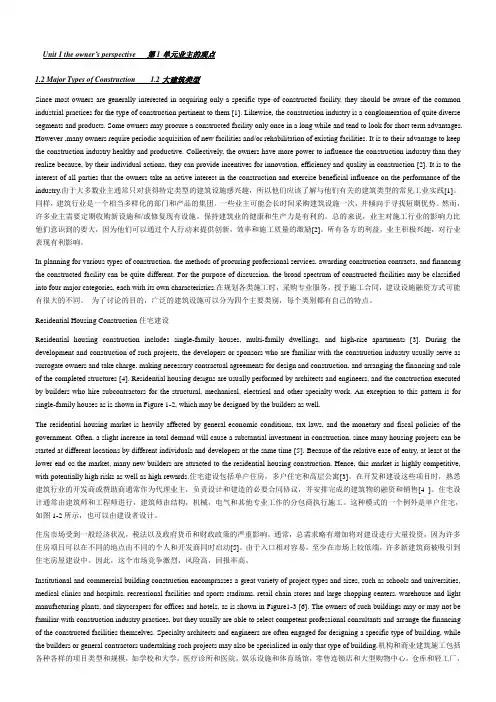
Unit 1 the owner’s perspective 第1单元业主的观点1.2 Major Types of Construction 1.2大建筑类型Since most owners are generally interested in acquiring only a specific type of constructed facility, they should be aware of the common industrial practices for the type of construction pertinent to them [1]. Likewise, the construction industry is a conglomeration of quite diverse segments and products. Some owners may procure a constructed facility only once in a long while and tend to look for short term advantages. However ,many owners require periodic acquisition of new facilities and/or rehabilitation of existing facilities. It is to their advantage to keep the construction industry healthy and productive. Collectively, the owners have more power to influence the construction industry than they realize because, by their individual actions, they can provide incentives for innovation, efficiency and quality in construction [2]. It is to the interest of all parties that the owners take an active interest in the construction and exercise beneficial influence on the performance of the industry.由于大多数业主通常只对获得特定类型的建筑设施感兴趣,所以他们应该了解与他们有关的建筑类型的常见工业实践[1]。
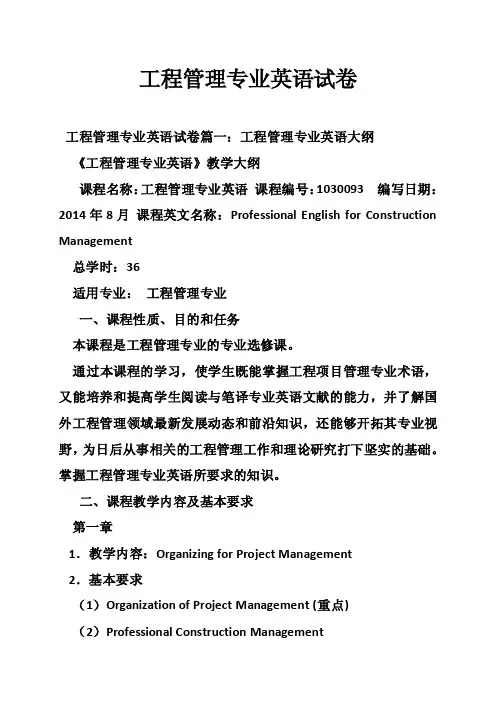
工程管理专业英语试卷工程管理专业英语试卷篇一:工程管理专业英语大纲《工程管理专业英语》教学大纲课程名称:工程管理专业英语课程编号:1030093 编写日期:2014年8月课程英文名称:Professional English for Construction Management总学时:36适用专业:工程管理专业一、课程性质、目的和任务本课程是工程管理专业的专业选修课。
通过本课程的学习,使学生既能掌握工程项目管理专业术语,又能培养和提高学生阅读与笔译专业英语文献的能力,并了解国外工程管理领域最新发展动态和前沿知识,还能够开拓其专业视野,为日后从事相关的工程管理工作和理论研究打下坚实的基础。
掌握工程管理专业英语所要求的知识。
二、课程教学内容及基本要求第一章1.教学内容:Organizing for Project Management2.基本要求(1)Organization of Project Management (重点)(2)Professional Construction Management3.学时分配:4学时第二章1.教学内容:The Employer2.基本要求(1)right of access to The site(2)employer claims(3)instructions3.学时分配:4学时第三章1.教学内容:Cost Estimation2.基本要求(1)Approaches to Cost Estimation (重点) (2)Types of Construction Cost Estimates 3.学时分配:4学时第四章1.教学内容:The Project Budget(1)2.基本要求(1)Set of Project Cost Accounts(2)Project Budget for a Design Firm (3)Project Budget for a Constructor3.学时分配:4学时第五章1.教学内容:The Project Budget(2)2.基本要求(1)How to Forecast for Activity Cost Control(2)Learn the Example 5.1 Estimate total cost3.学时分配:4学时第六章1.教学内容:The Contractor2.基本要求(1)The Contractor General Obligations(2)Contractor Representative(重点难点)(3)Progress Reports3.学时分配:4学时第七章1.教学内容:Types of Construction Contracts2.基本要求(1)Principles of Competitive Bidding(2)the Major Factors Impacting Bidding Competitions 3.学时分配:4学时第八章1.教学内容:Project Finance2.基本要求(1)Definition,Principle Advantages and Objectives(2)the Step in a Project Financing(3)Principle Agreements in a Project Financing3.学时分配:4学时第九章1.教学内容:Schedule Control2.基本要求(1)Project Control Process(2)Effects of Actual Schedule Performance(重点难点)(3)Incorporating Project Changes into The Schedule3.学时分配:4学时三、考核方式与成绩评定1.考核方式:考试2.成绩评定:各教学环节占总分的比例:作业、课堂表现、出勤:30%;期末考试:70%。
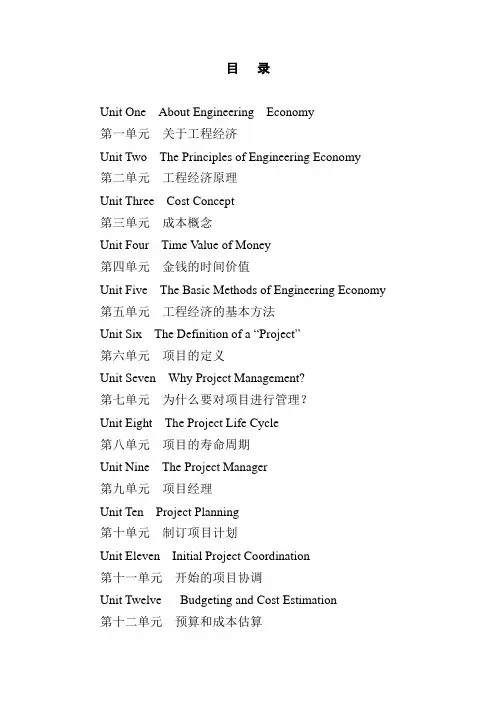
目录Unit One About Engineering Economy第一单元关于工程经济Unit Two The Principles of Engineering Economy第二单元工程经济原理Unit Three Cost Concept第三单元成本概念Unit Four Time Value of Money第四单元金钱的时间价值Unit Five The Basic Methods of Engineering Economy 第五单元工程经济的基本方法Unit Six The Definition of a “Project”第六单元项目的定义Unit Seven Why Project Management?第七单元为什么要对项目进行管理?Unit Eight The Project Life Cycle第八单元项目的寿命周期Unit Nine The Project Manager第九单元项目经理Unit Ten Project Planning第十单元制订项目计划Unit Eleven Initial Project Coordination第十一单元开始的项目协调Unit Twelve Budgeting and Cost Estimation第十二单元预算和成本估算Unit Thirteen The Monitoring System of Project第十三单元项目监测系统Unit Fourteen Project Control第十四单元项目控制Unit Fifteen Conditions of Contract for Construction(Excerpts)第十五单元施工合同条件(节选)Unit One About Engineering EconomyEngineering economy——what is it, and why is it important? The initial reaction of many engineering students to these questions is “Money matters will be handled by someone else. It is not something I need to worry about.” In reality, any engineering project must be not only physically realizable, but also economically affordable. For example, a child's tricycle could be built with an aluminum frame or a composite frame. Some may argue that because the composite frame will be stronger and lighter, it is a better choice. However, there is not much of a market for thousand dollar tricycles! One might suggest that this argument is ridiculously simplistic and that common sense would dictate choosing aluminum for the framing material. Although the scenario is an exaggeration, it reinforces the idea that the economic factors of a design weigh heavily in the design process, and that engineering economy is an integral part of that process, regardless of the engineering discipline. Engineering, without economy, makes no sense at all.In broad terms, for an engineering design to be successful, it must be technically sound and produce benefits. These benefits must exceed the costs associated with the design in order for the design to enhance net value. The field of engineering economy is concerned with the systematic evaluation of the benefits and costs of projects involving engineering design and analysis. In other words, engineering economy quantifies the benefits and costs associated with engineering projects to determine whether they make (or save) enough money to warrant their capital investments. Thus, engineering economy requires the application of engineering design and analysis principles to provide goods and services that satisfy the consumer at an affordable cost. As we shall see, engineering economy is as relevant to the design engineer who considers material selection as it is to the chief executive officer whoapproves capital expenditures for new ventures.The technological and social environments in which we live continue to change at a rapid rate. In recent decades, advances in science and engineering have made space travel possible, transformed our transportation systems, revolutionized the practice of medicine, and miniaturized electronic circuits so that a computer can be placed on a semiconductor chip. The list of such achievements seems almost endless. In your science and engineering courses, you will learn about some of the physical laws that underlie these accomplishments.The utilization of scientific and engineering knowledge for our benefit is achieved through the design of things we use, such as machines, structures, products, and services. However, these achievements don't occur without a price, monetary or otherwise. Therefore, the purpose of this book is to develop and illustrate the principles and methodology required to answer the basic economic question of any design: Do its benefits exceed its costs?The Accreditation Board for Engineering and Technology states that engineering “is the profession in which a knowledge of the mathematical and natural sciences gained by study, experience, and practice is applied with judgment to develop ways to utilize, economically, the materials and forces of nature for the benefit of mankind.”*In this definition, the economic aspects of engineering are emphasized, as well as the physical aspects. Clearly, it is essential that the economic part of engineering practice be accomplished well.Therefore,engineering economy is the dollars-and-cents side of the decisions that engineers make or recommend as they work to position a firm to be profitable in a highly competitive marketplace.Inherent to these decisions are trade-offs among different types of costs and the performance(response time,safety, weight, reliability, etc.) provided by the proposed design or problem solution.The mission of engineering economy is to balance thesetrade-offs in the most economical manner. For instance, if an engineer at Ford Motor Company invents a new transmission lubricant that increases fuel mileage by 10% and extend s the life of the transmission by 30,000 miles,how much can the company afford to spend to implement this invention? Engineering economy can provide an answer.A few more of the myriad situations in which engineering economy plays a cruclal role come to mind:1. Choosing the best design for a high-efficiency gas furnace.2. Selecting the most suitable robot for a welding operation on an automotive assembly line.3. Making a recommendation about whether jet airplanes for an overnight delivery service should be purchased or leased.4. Determining the optimal staffing plan for a computer help desk.From these illustrations,it should be obvious that engineering economy includes significant technical considerations.Thus,engineering economy involves technical analysis with emphasis on the economic aspects, and has the objective of assisting decisions.This is true whether the decision maker is an engineer interactively analyzing alternatives at a computer-aided design workstation or the Chief Executive Officer(CEO)considering a new project.A n engineer who is unprepared to excel at engineering economy is not properly equipped for,his or her job.Cost considerations and comparisons are fundamental aspects of engineering practice.This basic point was emphasized in Section 1.1. However, the development of engineering economy methodology, which is now used in nearly all engineering work,is relatively recent.This does not mean that,historically, costs were usually overlooked in engineering decisions. However, the perspective that ultimate economy is a primary concern to the engineer and the availability of sound techniques to address this concern differentiate this aspect of modern engineering practicefrom that of the past.A pioneer in the field was Arthur M.Wellington, a civil engineer, who in the latter part of the nineteenth century specifically addressed the role of economic analysis in engineering projects. His particular area of interest was railroad building in the United States.This early work was followed by other contributions in which the emphasis was on techniques that depended primarily on financial and actuarial mathematics.In 1930. Eugene Grant published the first edition of his textbook.+ This was a milestone in the development of engineering economy as we know it today. He placed emphasis on developing an economic point of view in engineering,and(as he stated in the preface) “this point of view involves a realization that quite as definite a body of principles governs the economic aspects of an engineering decision as governs its physical aspects.” In 1942,Woods and DeGarmo wrote the first edition of this book,later titled Engineering Economy.Unit Two The Principles of Engineering EconomyThe development, study, and application of any discipline must begin with a basic foundation.We define the foundation for engineering economy to be a set of principles,or fundamental concepts,that provide a comprehensive doctrine for developing the methodology, These principles will be mastered by students as they progress through this book. However, in engineering economic analysis, experience has shown that most errors can be traced to some violation of or lack of adherence to the basic principles.Once aproblem or need has been clearly defined, the foundation of the discipline can be discussed in terms of seven principles.PRINCIPLE1-DEVELOP THE ALTERNATIVES:The choice(decision) is among alternatives. The alternatives need to be identified and then defined for subsequent analysisA decision situation involves making a choice among two or more alternatives. Developing and defining the alternatives for detailed evaluation is important because of the resulting impact on the quality of the decision.Engineers and managers should place a high priority on this responsibility.Creativity and innovation are essential to the process.One alternative that may be feasible in a decision situation is making no change to the current operation or set of conditions(i.e., doing nothing). If you judge this option feasible,make sure it is considered in the analysis. However, do not focus on the status quo to the detriment of innovative or necessary change.PRINCIPLE2-FOCUS ON THE DIFFERENCES:Only the differences in expected future outcomes among the alternatives are relevant to their comparison and should be considered in the decision.If all prospective outcomes of the feasible alternatives were exactly the same,there would be no basis or need for comparison.We would be indifferent among the alternatives and could make a decision using a random selection.Obviously, only the differences in the future outcomes of the alternatives are important.Outcomes that are common to all alternatives can be disregarded in the comparison and decision.For example,if your feasible housing alternatives were two residences with the same purchase(or rental)price,price would be inconsequential to your final choice.Instead,the decision would depend on other factors, such as location and annual operating and maintenance expenses. This example illustrates,in a simple way, Principle 2,which emphasizes the basic purpose of an engineeringeconomic analysis:to recommend a future course of action based on the differences among feasible alternatives.PRINCIPLE 3-USE A CONSISTENT VIEWPOINT:The prospective outcomes of the alternatives, economic and other, should be consistently developed from a defined viewpoint (perspective).The perspective of the decision maker, which is often that of the owners of the firm,would normally be used.However, it is important that the viewpoint for the particular decision be first defined and then used consistently in the description analysis,and comparison of the alternatives.As an example,consider a public organization operating for the purpose of developing a river basin,including the generation and wholesale distribution of electricity from dams on the river system.A program is being planned to upgrade and increase the capacity of the power generators at two sites. What perspective should be used in defining the technical alternatives for the program? The “owners of the firm” in this example means the segment of the public that will pay the cost of the program and their viewpoint should be adopted in this situation.Now let us look at an example where the viewpoint may not be that of the owners of the firm.Suppose that the company in this example is a private firm and that the problem deals with providing a flexible benefits package for the employees. Also, assume that the feasible alternatives for operating the plan all have the same future costs to the company.The alternatives,however, have differences from the perspective of the employees,and their satisfaction is an important decision criterion. The viewpoint for this analysis and decision should be that of the employees of the company as a group, and the feasible alternatives should be defined from their perspective.PRINCIPLE 4-USE A COMMON UNIT OF MEASURE:Using a common unit of measurement to enumerate asmany of the prospective outcomes as possible will simplify the analysis and comparison of the alternatives.It is desirable to make as many prospective outcomes as possible commensurable (directly comparable).For economic consequences,a monetary unit such as dollars is the common measure.You should also try to translate other outcomes(which do not initially appear to be economic) into the monetary unit.This translation,of course, will not be feasible with some of the outcomes, but the additional effort toward this goal will enhance commensurabilitv and make the subsequent analysis and comparison of alternatives easier.What should you do with the outcomes that are not economic(i.e., the expected consequences that cannot be translated (and estimated) using the monetary unit)? First, if possible, quantify the expected future results using an appropriate unit of measurement for each outcome.If this is not feasible for one or more outcomes,describe these consequences explicitly so that the information is useful to the decision maker in the comparison of the alternatives.PRINCIPLE 5-CONSIDER ALL RELEV ANT CRITERIASelection of a preferred alternative (decision making) requires the use of a criterion (or several criteria). The decision process should consider both the outcomes enumerated in the monetary unit and those expressed in some other unit of measurement or made explicit in a descriptive manner.The decision maker will normally select the alternative that will best serve the long-term interests of the owners of the organization. In engineering economic analysis, the primary criterion relates to the long-term financial interests of the owners. This is based on the assumption that available capital will be allocated to provide maximum monetary return to the owners. Often, though, there are other organizational objectives you would like to achieve with your decision, and these should be considered and given weight in the selection of an alternative. These nonmonetarv attributes andmultiple objectives become the basis for additional criteria in the decision-making process.PRINCIPLE6-MAKE UNCERTAINTY EXPLICIT:Uncertainty is inherent in projecting (or estimating) the future outcomes of the alternatives and should be recognized in their analysis and comparison.The analysis of the alternatives involves projecting or estimating the future consequences associated with each of them.The magnitude and the impact of future outcomes of any course of action are uncertain.Even if the alternative involves no change from current operations, the probability is high that today‟s estimates of, for example,future cash receipts and expenses will not be what eventually occurs. Thus, dealing with uncertainty is an important aspect of engineering economic analysis and is the subject of Chapters 10 and 13.PRINCIPLE 7- REVISIT YOUR DECISIONS:Improved decision making results from an adaptive process, to the extent practicable, the initial projected outcomes of the selected alternative should be subsequently compared with actual results achieved.A good decision-making process can result in a decision that has an undesirable outcome. Other decisions, even though relatively successful,will have results significantly different from the initial estimates of the consequences. Learning from and adapting based on our experience are essential and are indicators of a good organization.The evaluation of results versus the initial estimate of outcomes for the selected alternative is often considered impracticable or not worth the effort. Too often, no feedback to the decision-making process occurs. Organizational discipline is needed to ensure tha t implemented decisions are routinely postevaluated and that the results used to improve future analyses of alternatives and the quality of decision making.The percentage of important decisions inan organization that are not postevaluated should be small.For example,a common mistake made in the comparison of alternatives is the failure to examine adequately the impact of uncertainty in the estimates for selected factors on the decision.Only postevaluations will highlight this type of weakness in the engineering economy studies being done in an organization.Unit Three Cost Concept3.1 Fixed, Variable, and Incremental CostsFixed costs are those unaffected by changes in activity level over a feasible range of operations for the capacity or capability available. Typical fixed costs include insurance and taxes on facilities, general management and administrative salaries, license fees, and interest costs on borrowed capital.Of course, any cost is subject to change, but fixed costs tend to remain constant over a specific range of operating conditions. When large changes in usage of resources occur, or when plant expansion or shutdown is involved, fixed costs will be affected.Variable costs are those associated with an operation that vary in total with the quantity of output or other measures of activity level. If you were making an engineering economic analysis of a proposed change to an existing operation, the variable costs would be the primary part of the prospective differences between the present andchanged operations as long as the range of activities is not significantly changed. For example, the costs of material and labor used in a product or service are variable costs, because they vary in total with the number of output units, even though the costs per unit stay the same.An incremental cost (or incremental revenue) is the additional cost (or revenue) that results from increasing the output of a system by one (or more) units. Incremental cost is often associated with “go-no go” decisions that involve a limited change in output or activity level.③For instance, the incremental cost per mile for driving an automobile may be. $0.27, but this cost depends on considerations such as total mileage driven during the year (normal operating range), mileage expected for the next major trip, and the age of the automobile. Also, it is common to read of the “incremental cost of producing a barrel of oil” and “incremental cost to the state for educating a student.” As these examples indicate, the incremental cost (or revenue) is often quite difficult to determine in practice.3.2 Recurring and Nonrecurring CostsThese two general cost terms are often used to describe various types of expenditures. Recurring costs are those that are repetitive and occur when an organization produces similar goods or services on a continuing basis. Variable costs are also recurring costs, because they repeat with each unit of output. But recurring costs are not limited to variable costs. A fixed cost that is paid on a repeatable basis is a recurring cost. For example, in an organization providing architectural and engineering services, office space rental, which is a fixed cost, is also a recurring cost.Nonrecurring costs, then, are those which are not repetitive, even though the total expenditure may be cumulative over a relatively short period of time. Typically, nonrecurring costs involve developing or establishing a capability or capacity to operate. For example, the purchase cost for real estate upon which a plant will bebuilt is a nonrecurring cost, as is the cost of constructing the plant itself.3.3 Direct, Indirect, and Standard CostsThese frequently encountered cost terms involve most of the cost elements that also fit into the previous overlapping categories of fixed and variable costs, and recurring and nonrecurring costs. Direct costs are costs that can be reasonably measured and allocated to a specific output or work activity. The labor and material costs directly associated with a product, service, or construction activity are direct costs. For example, the materials needed to make a pair of scissors would be a direct cost.Indirect costs are costs that are difficult to attribute or allocate to a specific output or work activity. The term normally refers to types of costs that would involve too much effort to allocate directly to a specific output. In this usage, they are costs allocated through a selected formula (such as, proportional to direct labor hours, direct labor dollars, or direct material dollars) to the outputs or work activities. For example, the costs of common tools, general supplies, and equipment maintenance in a plant are treated as indirect costs.Overhead consists of plant operating costs that are not direct labor or direct material costs. In this book, the terms indirect costs, overhead, and burden are used interchangeably. Examples of overhead include electricity, general repairs, property taxes, and supervision. Administrative and selling expenses are usually added to direct costs and overhead costs to arrive at a unit selling price for a product or service. (Appendix A provides a more detailed discussion of cost accounting principles.)Various methods are used to allocate overhead costs among products, services, and activities. The most commonly used methods involve allocation in proportion to direct labor costs, direct labor hours, direct materials costs, the sum of direct labor and direct materials costs (referred to as prime cost in a manufacturing operation), or machine hours. In each of these methods, it isnecessary to know what the total overhead costs have been or are estimated to be for a time period (typically a year) to allocate them to the production (or service delivery) outputs.Standard costs are representative costs per unit of output that are established in advance of actual production or service delivery. They are developed from anticipated direct labor hours, materials, and overhead categories (with their established costs per unit). Because total overhead costs are associated with a certain level of production, this is an important condition that should be remembered when dealing with standard cost data (for example, see Section 2.5.3). Standard costs play an important role in cost control and other management functions. Some typical uses are the following:1. Estimating future manufacturing costs.2. Measuring operating performance by comparing actual cost per unit with the standard unit cost.3. Preparing bids on products or services requested by customers.4. Establishing the value of work in process and finished inventories.3.4 Cash Cost versus Book CostA cost that involves payment of cash is called a cash cost (and results in a cash flow) to distinguish it from one that does not involve a cash transaction and is reflected in the accounting system as a noncash cost. This noncash cost is often referred to as a book cost. Cash costs are estimated from the perspective established for the analysis (Principle 3, Section 1.3) and are the future expenses incurred for the alternatives being analyzed. Book costs are costs that do not involve cash payments, but rather represent the recovery of past expenditures over a fixed period of time. The most common example of book cost is the depreciation charged for the use of assets such as plant and equipment. In engineering economic analysis, only those costs that are cash flows or potential cash flows from the defined perspective for the analysis need to be considered.Depreciation, for example, is not a cash flow and is important in an analysis only because it affects income taxes, which are cash flows. We discuss the topics of depreciation and income taxes in Chapter 6.3.5 Sunk CostA sunk cost is one that has occurred in the past and has no relevance to estimates of future costs and revenues related to an alternative course of action. Thus, a sunk cost is common to all alternatives, is not part of the future (prospective) cash flows, and can be disregarded in an engineering economic analysis. For instance, sunk costs are nonrefundable cash outlays, such as earnest money on a house or money spent on a passport.We need to be able to recognize sunk costs and then handle them properly in an analysis. Specifically, we need to be alert for the possible existence of sunk costs in any situation that involves a past expenditure that cannot be recovered, or capital that has already been invested and cannot be retrieved.The concept of sunk cost is illustrated in the next simple example. Suppose that Joe College finds a motorcycle he likes and pays $40 as a down payment, which will be applied to the $1,300 purchase price, but which must be forfeited if he decides not to take the cycle. Over the weekend, Joe finds another motorcycle he considers equally desirable for a purchase price of $1,230. For the purpose of deciding which cycle to purchase, the $40 is a sunk cost and thus, would not enter into the decision, except that it lowers the remaining cost of the first cycle. The decision then is between paying $1,260 ($1,300~$40) for the first motorcycle versus $1,230 for the second motorcycle.In summary, sunk costs result from past decisions and therefore are irrelevant in the analysis and comparison of alternatives that affect the future. Even though it is sometimes emotionally difficult to do, sunk costs should be ignored, except possibly to the extent that their existence assists you to anticipate better what will happen in the future.3.6 Opportunity CostAn opportunity cost is incurred because of the use of limited resources, such that the opportunity to use those resources to monetary advantage in an alternative use is foregone. Thus, it is the cost of the best rejected (i.e., foregone) opportunity and is often hidden or implied.For example, suppose that a project involves the use of vacant warehouse space presently owned by a company. The cost for that space to the project should be the income or savings that possible alternative uses of the space may bring to the firm. In other words, the opportunity cost for the warehouse space should be the income derived from the best alternative use of the space. This may be more than or less than the average cost of that space obtained from the accounting records of the company.Consider also a student who could earn $20,000 for working during a year, but chooses instead to go to school for a year and spend $5,000 to do so. The opportunity cost of going to school for that year is $25,000:$5,000 cash outlay and $20,000 for income foregone. (This figure neglects the influence of income taxes and assumes that the student has no earning capability while in school.)3.7 Life-Cycle CostIn engineering practice, the term life-cycle cost is often encountered. This term refers to a summation of all the costs, both recurring and nonrecurring, related to a product, structure, system, or service during its life span, The life cycle is illustrated in Figure 2-2. The life cycle begins with identification of the economic need or want (the requirement) and ends with retirement and disposal activities. It is a time horizon that must be defined in the context of the specific situation-whether it is a highway bridge, a jet engine for commercial aircraft, or an automated flexible manufacturing cell for a factory. The end of the life cycle may be projected on a functional or an economic basis. For example, the amount of time that a structure or piece of equipment is able to perform economically maybe shorter than that permitted by its physical capability. Changes in the design efficiency of a boiler illustrate this situation. The old boiler may be able to produce the steam required, but not economically enough for the intended use.Unit Four Time Value of Money4.1 IntroductionThe term capital refers to wealth in the form of money or property that can be used to produce more wealth. The majority of engineering economy studies involve commitment of capital for extended periods of time, so the effect of time must be considered. In this regard, it is recognized that a dollar today is worth more than a dollar one or more years from now because of the interest (or profit) it can earn. Therefore, money has a time value.4.2 Why Consider Return to Capital?Capital in the form of money for the people, machines, materials, energy, and other things needed in the operation of an。
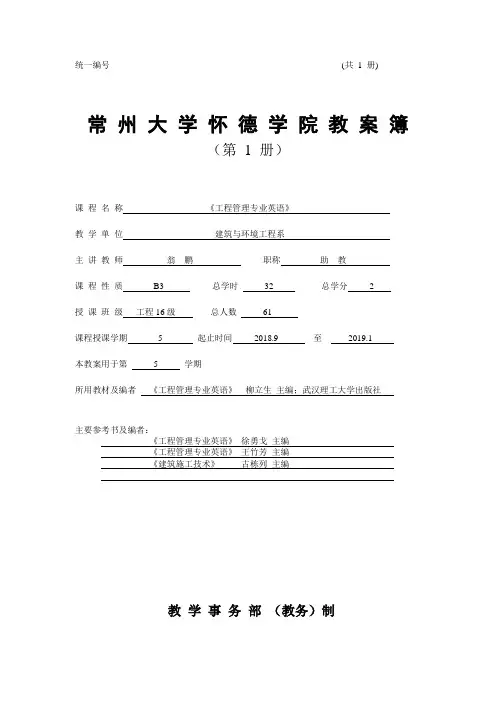
统一编号_____________ (共1 册)
常州大学怀德学院教案簿
(第 1 册)
课程名称《工程管理专业英语》
教学单位建筑与环境工程系
主讲教师翁鹏职称助教
课程性质B3 总学时32 总学分 2
授课班级工程16级总人数61
课程授课学期 5 起止时间2018.9 至2019.1
本教案用于第 5 学期
所用教材及编者《工程管理专业英语》柳立生主编;武汉理工大学出版社
主要参考书及编者:
《工程管理专业英语》徐勇戈主编
《工程管理专业英语》王竹芳主编
《建筑施工技术》古栋列主编
教学事务部(教务)制
本册教案目录
常州大学怀德学院教案
学生反馈。
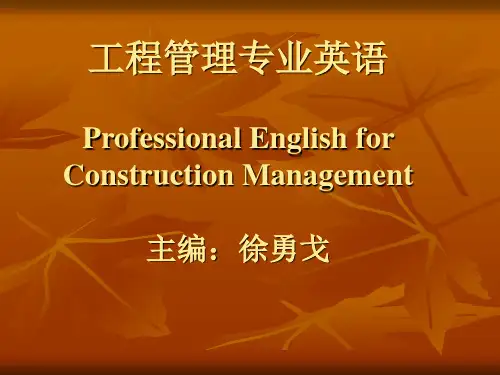
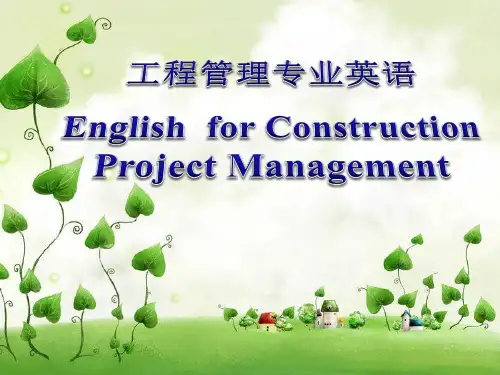
工程管理专业英语词汇 LG GROUP system office room 【LGA16H-LGYY-LGUA8Q8-LGA162】1、Construction industry 建筑业2、High-rise apartments 高层公寓3、Institution and commercial building construction 办公和商业用房建设4、Oligopoly 垄断,供过于求5、Specialized industrial construction 专业化工业项目建设6、Infrastructure and heavy construction 重大基础项目建设7、Residential housing construction 住宅类房屋建设8、Take charge 负责9、Single-family house 独户住宅10、Professional consultant 专业咨询人士11、General contractor 总承包商12、Mission-oriented 以目标(任务)为导向的13、Continuity 连续性14、Indispensable 不可或缺的15、Common-place 常见的16、Schedule 进度17、Maximization 最大化18、Communication 沟通19、Certification 认证20、Distinguish 区别,区分21、Predetermined 预定的22、Ingredient 组成部分,成分23、Linear programming 线性规划24、Trade off 均衡,权衡25、Delineation 叙述,说明26、Utilization 使用27、Integration 综合,整合28、Shop drawings 施工图,安装图29、Simultaneously 同时的30、Prebid site 投标前现场31、Nominated subcontractor 指定分包商32、Prequalified 预审合格33、An manual of professional practice 专业人员从业手册34、Risk-reward 风险和回报35、Structural design 结构设计36、Specialized subcontractor 专业分包商37、Work package 工作包38、Construction planning 施工计划39、Technical feasibility 技术可行性40、Construction operations 施工作业41、Structural or foundation details 结构或基础的具体情况42、Ingenuity and creativity 灵活性和创造性43、Construction constractors 施工承包商44、Monitoring and control 监督和控制45、Facility design 设施设计46、Estimate stage 估算阶段47、Evaluation stage 评估阶段48、equity partners 股权伙伴49. 、specifications and drawings 技术规范和图纸50.、Placing concrete on site 现场浇混凝土1、Job-site productivity 工地生产率2、Contractual agreements 合同3、Safety consciousness 安全意识4、Labor productivity 劳动生产率5、Foreign operations 国外施工6、Labor efficiency 劳动效率7、Infrastructure 基础设施8、Linear interpolation 线性内插9、Labor jurisdictions 劳动仲裁10、Non-productive activities 非生产性活动11、On-site 现场12、Labor characteristics 劳动力的特征13、Security sensitivity 安全敏感性14、Recognized strength 公认的实力15、Processing plant 加工厂16、Logistic problems 后勤问题17、Drilling platform 钻井平台18、Building construction 建筑施工19、Material procurement and delivery 材料采购和运输20、Bulk materials 大宗材料21、Overlapping and rehandling 搭接和再处理22、Semi-processed 半加工的,半成品的23、Concrete mix 混凝土拌和物24、Steel beams and columns 钢梁和柱25、. bills of quantity 工程量清单26、. minutes of the conference 会议纪要27、 the lowest evaluated cost 经评审的最低造价28、reimbursable expenses 可补偿费用29、.Hierarchical structure 层级结构30、Critical path scheduling 关键线路进度控制程序31、.bonus and penalty clauses 奖励和惩罚条款32、lump-sum agreement 总价合同33、.written authorization 书面授权34、unit-price agreement 单价合同35、Bids and quotations 投标和报价36、Off-the-shelf material 现货材料37、Earthwork to be excavated 土方开挖38 .general procurement notice 通用采购公告39、 . conditions of contract 合同条件40、Construction supervision 施工监督41、Freight delivery 货物运输44、Slippage or contraction 延误或提前45、.Marginal efficiency of capital 边际资本收益46、.Equivalent uniform annunual net value 等额净年值47、changes clause 变更条款49、 prequalification 资格预审49、limited international bidd ing 有限国际招标50、Unit Cost of Estimetion 单位估价1、Cost estimation 成本估算2、Cost engineering 工程估价3、Profitability 赢利4、Production function 生产函数5、Statistical inference 统计推断6、Construction equipment 施工机具7、General office overhead 总部管理费8、The cost engineer or estimator 估算师9、Cost control 成本控制10、Empirical cost inference 经验成本推论法11、Allocation of joint costs 综合成本的分摊12、Bill of quantities 工程量清单2、Cooling system 冷却系统3、Heat exchanger 热交换器4、Slabs and beams 楼板和梁5、Furnaces 锅炉6、Plus ancillary items 辅助设备7、Formwork 模板8、Detailed Estimates 详细估算9、Preliminary Estimates 详细估算10、Subcontractor Quotations 分包报价11、Construction Procedures 施工方法12、Factored Estimate Formula 系数估算公式13、Reinforcing bars 钢筋14、Building foundation 建筑物基础1、Economic evaluation 经济评价2、Sensitivity 灵敏度3、Planning horizon 规划周期4、Project alternative 备择项目5、Opportunity cost 机会成本6、Financial investment 金融投资7、Minium attractive rate of return 最低收益率8、Social rate discount 社会折现率9、Investment consideration 投资分析10、Decision maker 决策者11、Cash flow profile 现金流分布形态12、Net annual cash flow 年净现金流13、Capital project 资本项目14、Socially desirable programs 社会公益项目15、The Office of Management and Budget 财政部门16、Government agency 政府部门17、linear programming线性规划18、network analysis 网络分析19、Under ordinary circumstances, 在通常情况下20、best price/performance characteristics最优性价比特征21、an acceptable quality levelallowable可接受的质量水平22、a allowable fraction of defective items.可接受的缺陷比例23、ill structured棘手的24、critical ingredients关键因素25、identified as被看作为26、 the rate of return资本回收率cash flow 净现金流量options 融资方式finance 项目融资cash balance 负现金结余measure 利润指标值corporations 私营股份制公司agencies 公告机构34 instructions to bidders 投标人须知35 . conditions of contract合同条件uniform annunual net value 等额净年值recovory factor 资金回收因子cost ratio 收益费用比index 盈利指数40. prequalification 资格预审41. bidding documents 招标文件42. domestic contractor 国内承包商efficiency of capital 边际资本收益internal rate of capital 调整后的内部收益率on investment 投资收益46. international competitive bidd ing 竞争性国际招标47limited international bidd ing 有限国际招标competitive bidd ing 国内竞争性招标49 .general procurement notice 通用采购公告50 substantially responsive 实质性响应1. changes 工程变更2. contract awards 合同授予clause 变更条款financed priject 公共项目融资work 附加工作prime contractor 主承包商7. pre-construction sercices 施工前服务expenses 可补偿费用9. overhead and profit 管理费和利润planning 施工计划11. chioce of technology 施工技术的选择definition of work tasks 工作任务的定义problem 规范性问题control 成本控制control 进度控制path scheduling procedure关键线路进度控制程序shop scheduling procedure 工作现场进度控制程序and information systes m 数据库和信息系统duration of the activity 工作活动的持续时间concrete on site 现场浇筑混凝土21 Placing forms 支设模版22. Installing reinforcing steel 绑扎钢筋23. Pouring concrete 浇筑混凝土the concrete 混凝土养护25. Removing forms 模版拆除forms on the cleanning station 在清理场所码放模版 27. Hierarchical structure 层级结构fee 固定费用and profit 管理费和利润shop scheduling procedure 现场进度控制程序order 变更单–plus-fee agreement成本加费用合同takeoff 工程量清单34. prequalification 资格预审35、decomposed into 分解为the viewpoint of从某个角度看for 对某事负责to 优于。
Engineering project management is a comprehensive discipline that involves planning, executing, and closing projects. It is an essential part of the construction, manufacturing, and technology industries. This article will provide an overview of engineering project management, highlighting key concepts, processes, and tools.1. DefinitionEngineering project management is the application of knowledge, skills, tools, and techniques to project activities to meet the project requirements. It encompasses various activities, such as planning, executing, monitoring, controlling, and closing projects.2. Key Conceptsa. Project Scope: The defined deliverables and tasks that must be accomplished to deliver a complete and successful project.b. Project Schedule: The timeline for completing project activities and deliverables.c. Project Cost: The total amount of money required to complete the project.d. Quality: The degree of excellence of the project deliverables.e. Risk: The potential for an event to have a positive or negative impact on the project.3. Processesa. Initiating: Identifying and defining the project, including its objectives, scope, and stakeholders.b. Planning: Developing a detailed plan for executing, monitoring, and controlling the project activities.c. Executing: Implementing the project plan, including coordinating resources, managing stakeholders, and executing project activities.d. Monitoring and Controlling: Tracking, reviewing, and adjusting the project activities to ensure that the project objectives are met.e. Closing: Formalizing the completion of the project, including documentation, handover, and post-project evaluation.4. Tools and Techniquesa. Project Management Software: Tools like Microsoft Project, Oracle Primavera, and Atlassian Jira help in planning, scheduling, and tracking project activities.b. Critical Path Method (CPM): A project management technique that helps in identifying the sequence of activities and their dependencies.c. Agile Methodology: An iterative and incremental approach to project management that focuses on flexibility and collaboration.d. Risk Management: Identifying, analyzing, and mitigating risks to minimize their impact on the project.5. Professional Certificationsa. Project Management Professional (PMP): A certification offered by the Project Management Institute (PMI) that validates a professional's knowledge and skills in project management.b. Certified Project Manager (IAPM): A certification offered by the International Association of Project Managers (IAPM) that focuses on project management skills and knowledge.6. Challenges in Engineering Project Managementa. Complexity: Engineering projects are often complex, involving various stakeholders, activities, and technologies.b. Cost Control: Managing the project budget and ensuring that the project remains within the allocated budget.c. Time Management: Meeting project deadlines and delivering project deliverables on time.d. Communication: Ensuring effective communication among stakeholders, team members, and project managers.In conclusion, engineering project management is a crucial discipline that helps organizations successfully complete projects. By understanding the key concepts, processes, and tools, project managers can ensure that projects are completed on time, within budget, and to the required quality standards.。